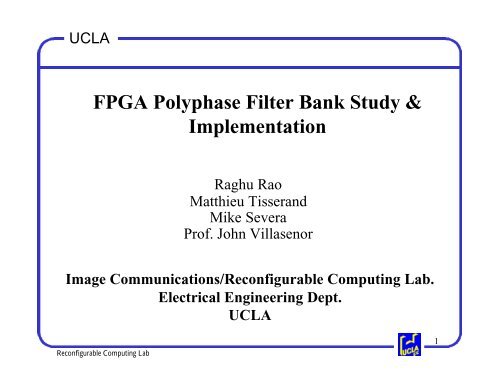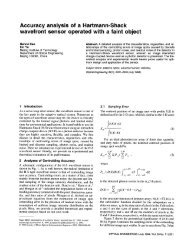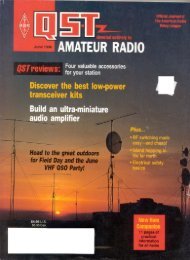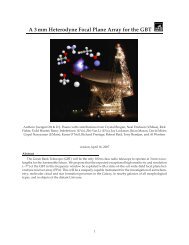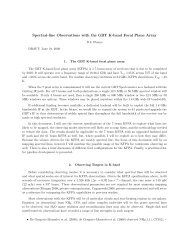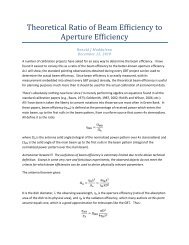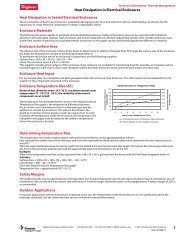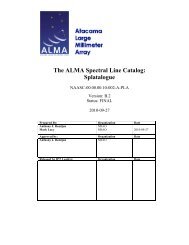FPGA Polyphase Filter Bank Study & Implementation
FPGA Polyphase Filter Bank Study & Implementation
FPGA Polyphase Filter Bank Study & Implementation
Create successful ePaper yourself
Turn your PDF publications into a flip-book with our unique Google optimized e-Paper software.
UCLA<br />
<strong>FPGA</strong> <strong>Polyphase</strong> <strong>Filter</strong> <strong>Bank</strong> <strong>Study</strong> &<br />
<strong>Implementation</strong><br />
Raghu Rao<br />
Matthieu Tisserand<br />
Mike Severa<br />
Prof. John Villasenor<br />
Image Communications/Reconfigurable Computing Lab.<br />
Electrical Engineering Dept.<br />
UCLA<br />
Reconfigurable Computing Lab<br />
1
UCLA<br />
Introduction<br />
This document describes a polyphase filter bank and<br />
summarizes the results of a feasibility study of its<br />
implementation on <strong>FPGA</strong>-based architectures with<br />
respect to size, timing and bandwidth requirements<br />
Under the SLAAC program, UCLA and Los Alamos<br />
National Labs have collaborated in mapping new<br />
adaptive algorithms to configurable computing platforms<br />
Reconfigurable Computing Lab<br />
2
UCLA<br />
Project Goals<br />
The current portion of the collaboration has involved the<br />
feasibilty and implementation of a <strong>Polyphase</strong> <strong>Filter</strong> bank<br />
using various <strong>FPGA</strong>s and hardware architectures.<br />
The <strong>Polyphase</strong> implementation is a multi-rate filter structure<br />
combined with a DFT designed to extract subbands from an<br />
input signal<br />
It is an optimization of the standard approaches and offers<br />
increased efficiency in both size and speed, aspects that are<br />
well suited to reconfigurable computing<br />
Task heretofore implemented only in ASIC; offers a good<br />
opportunity as an example of migration from ASIC to an<br />
Adaptive platform<br />
Reconfigurable Computing Lab<br />
3
UCLA<br />
Basic Project Parameters<br />
• 128 Megasamples/sec input signal<br />
• 16 distinct subband outputs<br />
• Implement using <strong>Polyphase</strong> filter and DFT structure<br />
128 Mss<br />
Poly-DFT<br />
Reconfigurable Computing Lab<br />
4
UCLA<br />
<strong>Polyphase</strong> <strong>Filter</strong> Architecture<br />
Input<br />
samples<br />
C<br />
O<br />
M<br />
M<br />
U<br />
T<br />
A<br />
T<br />
O<br />
R<br />
<strong>Polyphase</strong><br />
filter<br />
bank<br />
FFT<br />
16 positive<br />
frequency<br />
bins<br />
Reconfigurable Computing Lab<br />
5
UCLA<br />
<strong>Polyphase</strong> <strong>Filter</strong> Architecture<br />
Commutator:<br />
• distributes signal to n lines<br />
• reduces clock speed by factor of n<br />
<strong>Polyphase</strong> <strong>Filter</strong> bank:<br />
• 32 1-input, 1-output polyphase filters or<br />
• 16 1-input, 2-output optimized polyphase filters<br />
FFT:<br />
• 2n-point real FFT<br />
• n-point complex FFT<br />
Reconfigurable Computing Lab<br />
6
UCLA<br />
System Requirements<br />
8 to 16 bits<br />
@ 32MHz<br />
8 to 16 bits<br />
@ 32MHz<br />
Poly-DFT<br />
• 128MHz system speed<br />
• Note: 4 samples at 32MHz equivalent to one sample at 128 MHz<br />
• All lines are buses equal to sample precision (from 8 to 16 bits)<br />
• Precision has been implemented as a generic in VHDL<br />
• makes precision configurable<br />
• allows easy assessment of precision’s affect on feasibility<br />
Reconfigurable Computing Lab<br />
7
UCLA<br />
What Happens Inside?<br />
• Data will be sent to 32 filters...<br />
• i.e., need to be latched and further demuxed by factor of 8<br />
• Clock speed reduced also by factor of 8 to 4MHz<br />
Demux<br />
32MHz<br />
Reconfigurable Computing Lab<br />
4MHz<br />
8
UCLA<br />
And then?<br />
• Some work gets done<br />
• <strong>Polyphase</strong> filtering, DFT: @ 4MHz<br />
• note: using resource-sharing filter structures, initial decimation only<br />
by factor of 4, smaller filter bank, work gets done @ 8MHz (slides<br />
on this method later)<br />
Poly-DFT<br />
32MHz<br />
Reconfigurable Computing Lab<br />
4MHz<br />
9
UCLA<br />
And finally?<br />
• 16 samples at 4MHz are available to the remuxing logic<br />
• 16 samples are required for system<br />
• Re-Mux runs at 16MHz and samples 4 DFT outputs at a time<br />
• Results data has latency of a minimum of 12 clock cycles due to<br />
demux/remux (plus polyphase/DFT latency)<br />
Re-mux<br />
32MHz<br />
Reconfigurable Computing Lab<br />
4MHz<br />
16MHz<br />
10
UCLA<br />
<strong>Polyphase</strong> <strong>Filter</strong> <strong>Bank</strong>s<br />
The following slides describe the regular polyphase filter<br />
bank, the transpose form FIR filter, and optimizations based<br />
on symmetry<br />
This is a symmetric FIR filter, i.e., the first n/2 and the last n/2<br />
coeffs are the same, albeit in reverse order.<br />
We can exploit this symmetry to implement an optimal form<br />
of the filter bank, using resource sharing.<br />
We also describe two methods of exploiting resource sharing.<br />
The advantage of these schemes is the reduction in the size of<br />
both the filter bank and the commutator.<br />
Reconfigurable Computing Lab<br />
11
UCLA<br />
The <strong>Polyphase</strong> <strong>Filter</strong> bank Design<br />
• First step is to design a prototype low-pass, FIR filter h(n)<br />
with the desired filter parameters<br />
• The I polyphase filters p k , each of integer length K = M/I<br />
are derived from the length M FIR filter h(n) via<br />
• p k (n) = h(k + nI), k = 0..I-1, n = 0..K-1<br />
• (M is selected to be a multiple of I)<br />
Reconfigurable Computing Lab<br />
12
UCLA<br />
Our <strong>Polyphase</strong> Design<br />
• K = M/I : M = 128, K = 4, I = 32<br />
• p k (n) = h(k + nI), k = 0..I-1, n = 0..K-1 :<br />
• p 0 = h(0 + 0), h(0 +32), h(0 + 64), h(0 + 96)<br />
• p 1 = h(1 + 0), h(1 + 32), h(1 + 64), h(1 + 96)<br />
•<br />
•<br />
•<br />
• p 31 = h(31 + 0), h(31 + 32), h(31 + 64), h(31 + 96)<br />
Reconfigurable Computing Lab<br />
13
UCLA<br />
Our <strong>Polyphase</strong> Design<br />
p 0<br />
p 1<br />
p 2<br />
h(0), h(32), h(64), h(96)<br />
h(1), h(33), h(65), h(97)<br />
h(2), h(34), h(66), h(98)<br />
•<br />
•<br />
•<br />
p 31<br />
h(31), h(63), h(95), h(127)<br />
Reconfigurable Computing Lab<br />
14
UCLA<br />
<strong>Polyphase</strong> filter bank, 32 filters with 4 taps each<br />
Decimate by 32<br />
32 - filters<br />
D<br />
F<br />
T<br />
Reconfigurable Computing Lab<br />
15
UCLA<br />
Symmetry - how is it useful?<br />
Reconfigurable Computing Lab<br />
16
UCLA<br />
Symmetric filter bank<br />
A1<br />
A2<br />
B1<br />
B2<br />
C1<br />
C2<br />
D1<br />
D2<br />
A3<br />
A4<br />
D4<br />
D3<br />
D2<br />
B3<br />
B4<br />
C4<br />
C3<br />
C2<br />
C3<br />
C4<br />
B4<br />
B3<br />
B2<br />
D3<br />
D4<br />
A4<br />
A3<br />
A2<br />
24 more filters<br />
24 more filters<br />
D1<br />
C1<br />
B1<br />
A1<br />
Reconfigurable Computing Lab<br />
17
UCLA<br />
Symmetry - how is it useful?<br />
• Given an n-tap filter with coefficients h(0..n)<br />
h0 h1 h2 h3 h4 h5 h6 h7 h8 h9 h10 h11 h12 h13 h14 h15<br />
• In a symmetric filter of n taps, coefficient h(i) = h(n-1-i),<br />
i.e., we can re-label the above filter coefficients as<br />
h0 h1 h2 h3 h4 h5 h6 h7 h7 h6 h5 h4 h3 h2 h1 h0<br />
• What does this mean for our polyphase structure?<br />
Reconfigurable Computing Lab<br />
18
UCLA<br />
Symmetry - how is it useful?<br />
• What does this mean for our polyphase structure?<br />
h0 h8<br />
h1 h9<br />
h2 h10<br />
h3 h11<br />
h4 h12<br />
h5 h13<br />
h6 h14<br />
h7 h15<br />
h0 h7<br />
h1 h6<br />
h2 h5<br />
h3 h4<br />
h4 h3<br />
h5 h2<br />
h6 h1<br />
h7 h0<br />
Reconfigurable Computing Lab<br />
19
UCLA<br />
Symmetry - how is it useful?<br />
• What does this mean for a polyphase structure?<br />
• We can reduce number of coefficient multipliers<br />
.. x15 .. x7<br />
.. x14 .. x6<br />
.. x13 .. x5<br />
.. x12 .. x4<br />
.. x11 .. x3<br />
.. x10 .. x2<br />
.. x9 .. x1<br />
.. x8 .. x0<br />
h0 h7<br />
h1 h6<br />
h2 h5<br />
h3 h4<br />
h4 h3<br />
h5 h2<br />
h6 h1<br />
h7 h0<br />
h0 h7<br />
h1 h6<br />
h2 h5<br />
h3 h4<br />
Reconfigurable Computing Lab<br />
20
UCLA<br />
Symmetry - how is it useful?<br />
• What does this mean for a polyphase structure?<br />
.. x15 .. x7 h0 h7<br />
x0 .. X8 ..<br />
.. x14 .. x6<br />
h1 h6<br />
x1 .. X9 ..<br />
.. x13 .. x5<br />
h2 h5<br />
x2 .. X10 ..<br />
.. x12 .. x4<br />
h3 h4<br />
x3 .. X11 ..<br />
Reconfigurable Computing Lab<br />
21
UCLA<br />
The Commutator<br />
The commutator is half the size for this architecture. After<br />
feeding 8 filters, it reverses direction.<br />
Samples<br />
1 to 8<br />
8<br />
9<br />
1 16<br />
It goes to filters 1, 2, 3, 4, 5, … 8 and then 8, 7, 6, 5, 4,<br />
3, 2, 1 and reverses direction again.<br />
Reconfigurable Computing Lab<br />
22
UCLA<br />
Symmetry - how is it useful?<br />
Hardware <strong>Implementation</strong><br />
Reconfigurable Computing Lab<br />
23
UCLA<br />
Transpose Form of the FIR filter<br />
x(n)<br />
h0 h1 h2 h3<br />
y(n)<br />
register adder multiplier<br />
Reconfigurable Computing Lab<br />
24
UCLA<br />
Resource Sharing Optimization - Scheme 1<br />
x(n)<br />
h0 h1 h2 h3<br />
Convolution of<br />
even samples<br />
y(n)<br />
y(n)<br />
Convolution of<br />
odd samples<br />
Reconfigurable Computing Lab<br />
Clocked for even samples<br />
Clocked for odd samples<br />
25
UCLA<br />
Resource Sharing Optimization - Scheme 2<br />
x(n)<br />
h0 h1 h2 h3<br />
even sample<br />
convolution<br />
y(n)<br />
y(n)<br />
odd sample<br />
convolution<br />
Reconfigurable Computing Lab<br />
Clocked for even samples<br />
Clocked for odd samples<br />
Control<br />
1 - odd<br />
0 - even<br />
26
UCLA<br />
Comparison of Schemes<br />
Multipliers Adders Registers Multiplexer Demultiplxr<br />
Regular 128 96 128 0 0<br />
Scheme 1 64 96 128 0 0<br />
Scheme2 64 48 256 112 16<br />
NOTE: schemes1 and 2, also reduce the size of the<br />
commutator. With these schemes only a N/2 commutator is<br />
needed (decimate by 16).<br />
Reconfigurable Computing Lab<br />
27
UCLA<br />
<strong>Polyphase</strong> filter bank with resource shared filters<br />
Decimate by 16 16<br />
resource<br />
sharing<br />
filters<br />
32 o/p<br />
32 point<br />
real<br />
D<br />
F<br />
T<br />
Since each filter convolves alternate samples, giving two<br />
outputs, one a convolution of even samples and the other a<br />
convolution of odd samples, it also acts to decimate by 2. So,<br />
the initial decimator needs to decimate only by 16.<br />
Reconfigurable Computing Lab<br />
28
UCLA<br />
The Commutator<br />
The commutator is half the size for this architecture. After<br />
feeding 16 filters, it reverses direction.<br />
Samples<br />
1 to 16<br />
16<br />
17<br />
1 32<br />
It goes to filters 1, 2, 3, 4, 5, … 16 and then 16... 6, 5,<br />
4, 3, 2, 1 and reverses direction again.<br />
Reconfigurable Computing Lab<br />
29
UCLA<br />
A clocking scheme to enable flipflops alternately<br />
The flipflops in different colors need to be latch data alternately.<br />
When blue is on, green is off. This can be<br />
accomplished by a 2 phase clocking scheme.<br />
Positive edge DFF<br />
Negative edge DFF<br />
Clock divider circuit<br />
Reconfigurable Computing Lab<br />
30
UCLA<br />
Alternate scheme using enable flipflops<br />
Clock<br />
enable<br />
Instead of positive and negative DFFs, enable FFs can be<br />
used to convolve alternate samples. This clock enable also<br />
can be used as the select line to the muxes and demuxes.<br />
Reconfigurable Computing Lab<br />
31
UCLA<br />
Initial Studies<br />
The initial work involved approaching the topic from a<br />
theoretical standpoint<br />
• understand polyphase theory<br />
• implement polyphase structure simulation<br />
• DSP Canvas<br />
• MatLab<br />
• create filter based on design specs from Fiore’s paper<br />
• generate initial size estimates based on knowledge of the<br />
size of components and number of CLB’s necessary to<br />
implement them on an <strong>FPGA</strong><br />
Reconfigurable Computing Lab<br />
32
UCLA<br />
Feasibility Experiments<br />
These experiments evaluated the feasibility of implementing<br />
the polyphase filter bank on an Altera Flex10K250A (part<br />
EPF10K250AGC599-1) a Xilinx XC40150 (part<br />
XC40150XV-09-BG560) and a Xilinx VirtexXCV1000 (part<br />
XCV1000-4-BG560)<br />
All experiments were synthesized using Synplify 5.1.4 and<br />
placed and routed with Maxplus2 9.1<br />
The filter bank consisted of a decimator at the input, feeding a<br />
bank of either 16 or 32, 4 tap filters (filters optimized for<br />
symmetry have 2 outputs). The outputs of the filter bank feed<br />
a commutator that “re-muxes” data onto 4 lines that will feed a<br />
DFT (assumption that the DFT is on another chip).<br />
Reconfigurable Computing Lab<br />
33
UCLA<br />
Results for non-symmetry optimized filter bank<br />
Flex10K250A, part EPF10k250AGC599-1, does<br />
not fit.<br />
The critical resource on an Altera Flex10K is the carry<br />
chain (fast interconnect) routing.<br />
32 filters, with 1 output each, not optimized for symmetry<br />
Reconfigurable Computing Lab<br />
34
UCLA<br />
Results for non-symmetry optimized filter bank<br />
Xilinx Virtex, part XCV1000-4-BG560<br />
AREA<br />
MAX FREQ<br />
D=8, C=13<br />
D=13, C=13<br />
D=15, C=13<br />
2130 of 12288 CLB<br />
slices, 17% of chip<br />
3740 of 12288 CLB<br />
slices, 30% of chip<br />
4030 of 12288 CLB<br />
slices. 33% of chip<br />
66.578 MHz<br />
64.583 MHz<br />
72.343 MHz<br />
This has 32 filters, with 1 output each, not optimized for<br />
symmetry<br />
D - data precision<br />
C - coeff precision<br />
Reconfigurable Computing Lab<br />
35
UCLA<br />
Results for symmetry optimized filter bank<br />
Flex10K250A, part EPF10k250AGC599-1<br />
AREA<br />
MAX FREQ<br />
D=8, C=13<br />
D=13, C=13<br />
D=14, C=13<br />
D=15, C=13<br />
4932 LEs<br />
40% of chip<br />
8109 LEs<br />
66% of chip<br />
8523 LEs<br />
70% of chip<br />
8975 LEs. 76% of<br />
chip. No Fit,<br />
routing resources<br />
22.47 MHz<br />
22.42 MHz<br />
22.02 MHz<br />
No Fit.<br />
This has 16 filters, with 2 outputs each, optimized for<br />
symmetry<br />
Reconfigurable Computing Lab<br />
36
UCLA<br />
Results for symmetry optimized filter bank<br />
Xilinx XC40150XV-09-BG560<br />
AREA<br />
MAX FREQ<br />
D=8, C=13<br />
2946 of 5184 CLB<br />
slices, 56% of chip<br />
31.448 MHz<br />
This has 16 filters, with 2 outputs each, optimized for<br />
symmetry<br />
Reconfigurable Computing Lab<br />
37
UCLA<br />
Results for symmetry optimized filter bank<br />
Xilinx Virtex XCV1000-4-BG560<br />
AREA<br />
MAX FREQ<br />
D=13, C=13<br />
3478 of 12288 CLB<br />
slices, 29% of chip<br />
65.561 MHz<br />
This has 16 filters, with 2 outputs each, optimized for<br />
symmetry<br />
Reconfigurable Computing Lab<br />
38
UCLA<br />
FFT <strong>Implementation</strong><br />
The following slides describe some optimizations of the<br />
FFT and how its inclusion into the system logic affects size<br />
and speed.<br />
• Goal of system is 16 distinct positive frequency bins<br />
• An N-point FFT produces N/2+1 distinct bins<br />
• Our input sequence is real<br />
• The FFT of a real valued sequence of 2N points can<br />
be computed efficiently by employing an N-point<br />
complex FFT<br />
Reconfigurable Computing Lab<br />
39
UCLA<br />
32-point Real FFT <strong>Implementation</strong><br />
X(n), the 2N point real sequence is divided into 2, N-point<br />
sequences as follows:<br />
h(k) = x(2k), k = 0, 1, …., N - 1<br />
g(k) = x(2k + 1), k = 0, 1, …., N - 1<br />
i.e.. The function h(k) is equal to the even-numbered samples<br />
of x(k), and g(k) is equal to the odd-numbered samples.<br />
A N-point complex valued sequence y(k) can be written as<br />
y(k) = h(k) + j g(k)<br />
The DFT of y(k) is then computed.<br />
Reconfigurable Computing Lab<br />
40
UCLA<br />
FFT cont’d.<br />
Y(k) = H(k) + W k 2N G(k), k = 0, 1, …., N-1<br />
Y(k + n) = H(k) - W k 2N G(k), k = 0, 1, …., N-1<br />
To compute the real and imag. parts of the output, H(k) and G(k)<br />
can be expressed in terms of even and odd components.<br />
H(k) = R e (k) + j I o (k)<br />
G(k) = I e (k) - j R o (k)<br />
Substituting this in Y(k), we get,<br />
Y(k) = Y r (k) + j Y i (k), where<br />
Reconfigurable Computing Lab<br />
41
UCLA<br />
FFT of a 2N point real sequence from a N point complex FFT<br />
Even<br />
samples<br />
real<br />
G(k)<br />
32 point real<br />
sequence<br />
Odd<br />
samples<br />
16 point<br />
complex<br />
FFT<br />
imag<br />
W k 2N<br />
G(k + N)<br />
Reconfigurable Computing Lab<br />
42
UCLA<br />
Area and delay numbers for the 32-point real FFT<br />
Data precision Timing Area Percentage of chip<br />
13 16.03 MHz<br />
2165 17% of chip<br />
62.3 ns<br />
14 16.47 MHz<br />
60.7 ns<br />
15 8.89 MHz<br />
112.4 ns<br />
16 15.31 MHz<br />
2413 19% of chip<br />
2654 21% of chip<br />
2876 23% of chip<br />
65.3 ns<br />
Altera Flex10K-250A GC599-1<br />
Xilinx xc40150-09-bg560: Area 2530 out of 5184(48% of chip), 20.001 MHz.<br />
Xilinx Virtex xcv1000-4-bg560: Area 1754 out of 12288(14% of chip), 48.96 MHz.<br />
(virtex precision 13 & 13, XC40150: 8 &13)<br />
Reconfigurable Computing Lab<br />
43
UCLA<br />
Full System Estimates<br />
The entire polyphase filter bank along with the FFT does not<br />
fit on an Altera Flex device. But it does fit on the Xilinx<br />
XC40150 and Virtex.<br />
Decimation factor = 32, 17 positive frequency bins<br />
Data precision = 13, Coeff precision = 13<br />
Xilinx xc40150-09-bg560 (D=8, C=13)<br />
4581 CLBs out of 5184 - 88% of chip.<br />
Freq: 20.492 MHz<br />
Xilinx Virtex - xcv1000-4-bg560<br />
7156 CLB slices out of 12288 - 58% of chip.(11631 LUTs).<br />
Freq: 56.715 MHz.<br />
Reconfigurable Computing Lab<br />
44
UCLA<br />
<strong>Polyphase</strong> filter bank on a Xilinx XC40150XV-09-BG560<br />
DESIGN<br />
XILINX<br />
XC40150XV-09-BG560<br />
XILINX VIRTEX<br />
XCV1000-4-BG560<br />
ALTERA<br />
FLEX10K250AGC599-1<br />
8 point data precision<br />
13 point coeff precision<br />
8 point data precision<br />
13 point coeff precision<br />
8 point data precision<br />
13 point coeff precision<br />
AREA<br />
TIMING<br />
AREA<br />
TIMING<br />
AREA<br />
TIMING<br />
Fir<br />
filterbank<br />
2946/5184<br />
CLBs 56%<br />
of chip<br />
Freq<br />
31.448<br />
MHz<br />
4932/12160<br />
LEs 40% of<br />
chip<br />
Freq<br />
22.47<br />
MHz<br />
32 point<br />
real FFT<br />
2530/5184<br />
48% of<br />
chip<br />
Freq<br />
20.001<br />
MHz<br />
2092/12160<br />
LEs 17% of<br />
chip<br />
Freq<br />
19.08<br />
MHz<br />
Full design<br />
(polyphase<br />
filter<br />
bank+fft)<br />
4581/5184<br />
88% of<br />
chip<br />
Freq<br />
20.492<br />
MHz<br />
4195/12288<br />
34% of chip<br />
Freq<br />
50.594<br />
MHz<br />
No Fit<br />
Reconfigurable Computing Lab<br />
45
UCLA<br />
Area and delay estimation flow<br />
VHDL<br />
Verify VHDL by checking the RTL<br />
level schematics, checking the number<br />
of adders, multipliers and registers.<br />
Synthesis<br />
RTL schematics<br />
Place &<br />
route<br />
Timing<br />
analysis<br />
Area report<br />
Timing report<br />
Reconfigurable Computing Lab<br />
46
UCLA<br />
RTL level schematics and design browser from Synplify<br />
Reconfigurable Computing Lab<br />
47
UCLA<br />
Future Work<br />
Simulate and test polyphase VHDL implementation using<br />
LANL test vectors<br />
Work together with LANL to facilitate possible demo of<br />
polyphase work<br />
Implement Scheme 2 of resource sharing symmetrical filter<br />
bank<br />
<strong>Study</strong> the advantages and disadvantages with regards to<br />
system goals of FFT replacing the FFT with a DCT<br />
Look into adaptive filtering techniques<br />
Modifying our current polyphase design to accommodate<br />
configurable or even programmable rate<br />
Reconfigurable Computing Lab<br />
48
UCLA<br />
Conclusions<br />
Very productive intitial phase of collaboration between<br />
UCLA and LANL<br />
Our work has resulted in some innovations at the<br />
algorithmic level<br />
Task migration from ASIC to <strong>FPGA</strong><br />
This study has provided useful sizing information for the<br />
Altera Flex and Xilinx Virtex families as well as some initial<br />
benchmarks of basic DSP methods used in UWB<br />
Reconfigurable Computing Lab<br />
49


